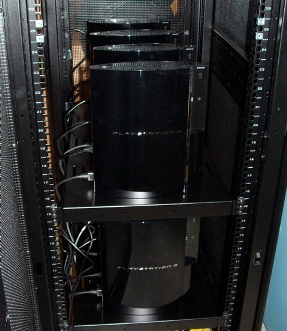Não sei se é novidade, mas eu não sabia.
E se for um tópico repetido podem apagar, apenas achei interessante.
Pic das 8 a trabalhar em simultaneo

PDF a explicar como montar um (Não sei se está correcto porque não consigo ver PDFs no meu PC):
http://www.netlib.org/utk/people/JackDongarra/PAPERS/scop3.pdf
Fonte:
http://http://www.wired.com/techbiz/it/news/2007/10/ps3_supercomputer
Cumpz
E se for um tópico repetido podem apagar, apenas achei interessante.
Astrophysicist Replaces Supercomputer with Eight PlayStation 3s
Suffering from its exorbitant price point and a dearth of titles, Sony's PlayStation 3 isn't exactly the most popular gaming platform on the block. But while the console flounders in the commercial space, the PS3 may be finding a new calling in the realm of science and research.
Right now, a cluster of eight interlinked PS3s is busy solving a celestial mystery involving gravitational waves and what happens when a super-massive black hole, about a million times the mass of our own sun, swallows up a star.
As the architect of this research, Dr. Gaurav Khanna is employing his so-called "gravity grid" of PS3s to help measure these theoretical gravity waves -- ripples in space-time that travel at the speed of light -- that Einstein's Theory of Relativity predicted would emerge when such an event takes place.
It turns out that the PS3 is ideal for doing precisely the kind of heavy computational lifting Khanna requires for his project, and the fact that it's a relatively open platform makes programming scientific applications feasible.
"The interest in the PS3 really was for two main reasons," explains Khanna, an assistant professor at the University of Massachusetts, Dartmouth who specializes in computational astrophysics. "One of those is that Sony did this remarkable thing of making the PS3 an open platform, so you can in fact run Linux on it and it doesn't control what you do."
He also says that the console's Cell processor, co-developed by Sony, IBM and Toshiba, can deliver massive amounts of power, comparable even to that of a supercomputer -- if you know how to optimize code and have a few extra consoles lying around that you can string together.
"The PS3/Linux combination offers a very attractive cost-performance solution whether the PS3s are distributed or clustered together", says Sony's senior development manager of research and development, Noam Rimon.
According to Rimon, the Cell processor was designed as a parallel processing device, so he's not all that surprised the research community has embraced it. "It has a general purpose processor, as well as eight additional processing cores, each of which has two processing pipelines and can process multiple numbers, all at the same time," Rimon says.
This is precisely what Khanna needed. Prior to obtaining his PS3s, Khanna relied on grants from the National Science Foundation (NSF) to use various supercomputing sites spread across the United States "Typically I'd use a couple hundred processors -- going up to 500 -- to do these same types of things."
However, each of those supercomputer runs cost Khanna as much as $5,000 in grant money. Eight 60 GB PS3s would cost just $3,200, by contrast, but Khanna figured he would have a hard time convincing the NSF to give him a grant to buy game consoles, even if the overall price tag was lower. So after tweaking his code this past summer so that it could take advantage of the Cell's unique architecture, Khanna set about petitioning Sony for some help in the form of free PS3s.
"Once I was able to get to the point that I had this kind of performance from a single PS3, I think that's when Sony started paying attention," Khanna says of his optimized code.
Khanna says that his gravity grid has been up and running for a little over a month now and that, crudely speaking, his eight consoles are equal to about 200 of the supercomputing nodes he used to rely on.
"Basically, it's almost like a replacement," he says. "I don't have to use that supercomputer anymore, which is a good thing."
"For the same amount of money -- well, I didn't pay for it, but even if you look into the amount of funding that would go into buying something like eight PS3s -- for the same amount of money I can do these runs indefinitely."
The point of the simulations Khanna and his team at UMass are running on the cluster is to see if gravitational waves, which have been postulated for almost 100 years but have never been observed, are strong enough that we could actually observe them one day. Indeed, with NASA and other agencies building some very big gravitational wave observatories with the sensitivity to be able to detect these waves, Khanna's sees his work as complementary to such endeavors.
Khanna expects to publish the results of his research in the next few months. So while PS3 owners continue to wait for a fuller range of PS3 titles and low prices, at least they'll have some reading material to pass the time.
Pic das 8 a trabalhar em simultaneo

PDF a explicar como montar um (Não sei se está correcto porque não consigo ver PDFs no meu PC):
http://www.netlib.org/utk/people/JackDongarra/PAPERS/scop3.pdf
Fonte:
http://http://www.wired.com/techbiz/it/news/2007/10/ps3_supercomputer
Cumpz

